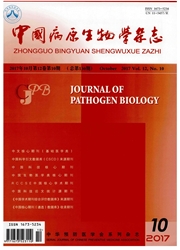

 中文摘要:
中文摘要:
有机体的生存需要不断应对变化的环境。信号转导系统的存在有助于生物对不同的内外界信号做出相应的回应。蛋白质的磷酸化是信号转导的重要机制,二元信号转导系统(two—component signal transduction system,TCSTS)是细菌最普遍的信号转导方式,然而最早在真核生物中发现的丝氨酸、苏氨酸的磷酸化在原核生物中已成为研究的热点。丝氨酸/苏氨酸激酶与磷酸酶的协同作用与致病菌各种生命活动息息相关,包括生长,代谢,毒力以及应激压力等。本文重点介绍几种常见的链球菌中的丝/苏氨酸激酶,了解其在致病菌中的作用。鉴于真核生物STK已有大量的抑制剂被广泛使用,对链球菌真核样丝/苏氨酸激酶STK(eukaryotic—like Ser/Thr kinase,eSTK)的深入了解将有助于寻找应对链球菌感染的预防和治疗手段。
 英文摘要:
英文摘要:
The survival of a living organism relies on its ability to quickly respond to a constantly changing environ ment. Signal-transducing systems are essential to that response. Protein phosphorylation is an important mechanism of signal transduction. The two-component signal transduction system (TCSTS) is ubiquitous in bacteria. However, phosphorylation of serine or threonine residues, originally found in eukaryotes, has increasingly garnered attention. The coop eration between serine/threonine kinases (STKs) and phosphatases (STPs) has been described as regulating cellular processes including cell growth, metabolism, virulence, and stress responses, This article describes STKs and their cognate phosphatases and it provides an overview of current research on their role in several familiar pathogens, such as Streptococcus agalactiae , Streptococcus pyogenes , Streptococcus pneumoniae , Streptococcus mutans , and Streptococcus suis. Comparison of the wild type of serine/threonine protein kinase (stk) genes and their mutants has shown that these genes affect cell growth, phenotype, and virulence. Understanding of the substrates and extracellular ligands of novel sig naling systems is limited. Efforts are still being made to provide greater insight into the molecular mechanisms of these genes. Given that many inhibitors of eukaryotic STK are commonly used, an understanding of eukaryotic-like Ser/Thr kinases (eSTKs) should prove useful. This should help to identify effective therapeutic strategies to treat bacterial infections.
 同期刊论文项目
同期刊论文项目
 同项目期刊论文
同项目期刊论文
 Rapid visual detection of highly pathogenic Streptococcus suis serotype 2 isolates by use of loop-me
Rapid visual detection of highly pathogenic Streptococcus suis serotype 2 isolates by use of loop-me Prevalent distribution and conservation of Streptococcus suis Lmbprotein and its protective capacity
Prevalent distribution and conservation of Streptococcus suis Lmbprotein and its protective capacity The beta-galactosidase (BgaC) of the zoonotic pathogen Streptococcus suis is a surface protein witho
The beta-galactosidase (BgaC) of the zoonotic pathogen Streptococcus suis is a surface protein witho Rapid and Sensitive Detection of H7N9 Avian Influenza Virus by Use of Reverse Transcription-Loop-Med
Rapid and Sensitive Detection of H7N9 Avian Influenza Virus by Use of Reverse Transcription-Loop-Med Prevalent distribution and conservation of Streptococcus suis Lmb protein and its protective capacit
Prevalent distribution and conservation of Streptococcus suis Lmb protein and its protective capacit 期刊信息
期刊信息
